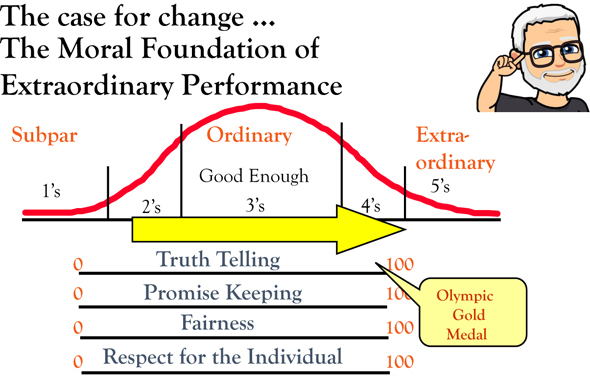Concept
Given the traditional method of ethics analysis introduced in the last chapter, executives decide, consciously or not, what they will do—and those decisions have big ethical implications. We all balance the consequences to stakeholders with our own VABEs.
Rich Teerlink, former CEO of Harley Davidson, had a powerful moral foundation for his leadership. He asserted that moral leaders exhibited four characteristics: truth-telling, promise-keeping, fairness, and respect for the individual.
Truth Telling is the beginning of transparency and authenticity. How often do you tell the truth? How often do you fudge the truth? Withhold it. Distort it. Bend it.
Promise Keeping is similar. If you break your promises, what will that do to your trustworthiness?
Fairness is equally as difficult to define. We talk of distributive justice, to each as they have earned. What is fair to one person may not be fair to another. Our stakeholder analysis would be useful here.
Respect for the Individual is something that many if not most people in power lose. They begin to see people as (like one colleague calls them) the little people. Or not people at all, simply replaceable assets.
I have come to believe that one can give speeches, introduce incentives, do periodic performance reviews, and hand out gold stars and extra stripes, but if they don’t have this four cornered foundation of moral leadership, his or her people will not be moved.
If you told your people the truth half of the time, would they follow you?
If you kept your promises to your people half of the time, would they follow you?
If you treated people fairly half of the time, would they follow you?
If you showed respect for individuals (at all levels) half of the time, would they follow you?
If you agree with me that the answers are “No,” then how often is good enough to motivate/move people?
Let’s put these four dimensions on a 1 to 100 point scale where 50 equals half of the time. Then you could ask your people to rate your organization and your leadership (anonymously) on them. I assert that if you aren’t getting “Olympic Gold Medal” ratings, 9.9, 9.7, 9.8, and the like on these four concepts, you won’t be able to raise the bar for your people. They simply won’t trust you.
Example
I once had the senior leadership of a large mid-western company in the room. At one point, we were debating the ethical question, “Should one tell the truth in business?” To my surprise, these suited executives were soon shouting at each other. One even stood on his chair and was shouting and pointing at his colleagues across the room. On the one side, people argued, “If you tell the truth, people will take advantage of you.” On the other side, people argued, “If you don’t tell the truth, people won’t trust you.” Hmmm.
A participant in one of my seminars once noted that his company was going to shut down his plant. His boss, the plant manager, called an executive meeting. In that meeting, he said, in essence, “We are going to shut down the plant. I don’t want you to tell anyone lest productivity drop off.” As the participant left the meeting, he was met by one of his subordinates in the hallway (who happened to be getting a drink of water from the nearby water fountain) who asked him, “Are we closing the plant?” To whom does this man owe his allegiance? If he reports the truth, “I cannot tell you that,” what will the message be?
I have reported earlier, the freeway construction company owner who sold his company for $200 million and immediately gave $1 million to each of his 100 employees. Most people were astounded by this. He saw it as simply being fair. “They did all the work,” he said. “And I still have $100 million!”
Ikujiro Nonaka describes the plant manager of a new state-of-the-art chip-factory who was struggling with rejection rates. His team worked hard for months and could not get their rejection rate into an acceptable range. One day, an elderly woman, a custodian, stopped him on the way into work and said she thought she had a solution. Now, how many plant managers in high tech industries would stop and listen to an elderly custodian? In my experience, most would not. The vast majority would not. She said that she noticed that when the local commuter train went by, the ground shook a little. She thought building a moat around the factory would dampen those shock waves and reduce the reject rate in the miniscule circuits on the chips. This manager listened, he had respect for the individuals at all levels in his organization, built the moat, and his reject rate dropped immediately.
Diagram

Source: Rich Teerlink, CEO Harley Davidson
Assessing the Moral Foundation of Your Leadership
(Copy and use with your team anonymously—adapted from Level Three LEadership, pp. 395) After you have discussed the moral foundation of leadership, use this form to begin your leadership team assessment. First, make copies of the form and give one to each member of your team and have them assess your team. Second, answer each question according to your view of your current management team and its interactions. Third, collect each team member’s answers (anonymously if you wish) and summarize the data. Fourth, hold a team meeting in which you discuss the results (average scores, variation, difference from expectations, or hopes) and make joint plans for how to improve your scores. To answer, circle the number that represents the percentage of the time that each principle describes your leadership team.
Percentage of the Time That This Principle |
||||||||||
1. Truth-Telling: We tell the truth to each other and don’t hide things or talk behind others’ backs. We know where each person stands. |
10 |
20 |
30 |
40 |
50 |
60 |
70 |
80 |
90 |
100 |
2. Promise-Keeping: We keep our promises to each other no matter how large or small. |
10 |
20 |
30 |
40 |
50 |
60 |
70 |
80 |
90 |
100 |
3. Fairness: We treat each other fairly and do not try to take advantage of each other. |
10 |
20 |
30 |
40 |
50 |
60 |
70 |
80 |
90 |
100 |
4. Respect for the Individual: We show respect for each other and other members of our organization in our speech, action, and courtesy. |
10 |
20 |
30 |
40 |
50 |
60 |
70 |
80 |
90 |
100 |
Team Scoring |
Team Average |
My Assessment |
Difference |
Truth-Telling |
|||
Promise-Keeping |
|||
Fairness |
|||
Respect for the Individual |
Note again that each of these principles is really only a different window onto the same central concept. In other words, if you tell the truth, you have to keep your promises. If you are fair, you will have respect for the individual.
Challenge
1. Complete your ratings on this assessment page on your team.
2. Distribute this assessment page to your team.
3. Have your administrative assistant gather and average the results.
4. Compare your assessment with the average of your employees.
5. Address any gaps. How can you raise the numbers?
